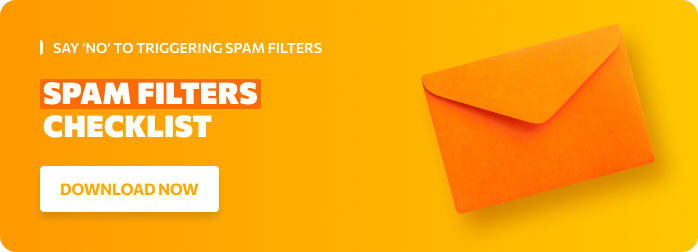A high bounce rate is a total ego-crusher. Finding out that the once glorious and hefty email list that you spent so much time building isn’t as great as you thought it was!
What a bummer! All that hard work for nothing?!
At the end of the day, who cares if you have thousands of hundreds of email addresses on your list if your emails hit the wall of the void and bounce back without ever reaching their intended recipients. There’s no way you could leverage all the astonishing benefits of email marketing if you can’t get through to your email subscribers.
That’s precisely why you need to watch your bounce rate and amend your email marketing efforts whenever the figure is too high. How? Good question!
In this article, we’re going to cover all there is to know about what email bounce rate is, what comprises it, why it gets higher over time, and how to prevent it from soaring through the roof. Keep reading!
What Is the Email Bounce Rate?
Email bounce rate is one of the email marketing metrics that allow you to assess your email campaigns’ performance. It reflects on the percentage of email addresses on your mailing list that never received the marketing communication you sent them via email because a recipient mail server returned the email.
Essentially, an email that bounced is the email that wasn’t delivered.
However, not all instances of undelivered emails are equal. Two types of bounces that contribute towards the overall bounce rate of an email campaign are soft bounces and hard bounces:
- Soft Bounces. These occur whenever an email bounces back after the recipient’s mail server has already accepted it. The most common cause of soft bounces is an overloaded email server, but they can also be caused by an email’s size (emails too large won’t go through) or the recipient email server’s status (down or offline). There isn’t much you can do to reduce soft bounces, but don’t worry. Your email service provider will try to resend the email campaign several times (up to five times) before giving up. Therefore, even without your participation in the process, soft bounces have a high chance of turning into a successful delivery after multiple attempts.
- Hard Bounces. These are more serious and detrimental for your email sender reputation as they aren’t temporary. Hard bounces are permanent email delivery failures - the emails you send bounce back to the sender undelivered without ever being accepted by the receiving email server. There are many reasons why hard bounces occur, with the most common ones being fake/outdated email addresses on the list, domains that no longer exist, and the receiving servers blocking delivery.
There are many reasons you should pay close attention to your email campaigns’ bounce rate. First of all, it can affect the overall deliverability of your future emails. If your campaigns consistently have a high bounce rate, you put your sender reputation at risk.
The worse your reputation is, the higher is the chance of your emails going straight into the spam folder, even for the recipients that actively engage with you. Even if it doesn’t seem like a big deal at first, after a while, you’ll start noticing a decline in your engagement levels, including lower open rates, CTR and, eventually, you’ll see your sales plummet as a result.
If you don’t want that to happen, you need to keep your finger on the pulse and regularly calculate your email bounce rate. Here’s the formula:
Bounce Rate = Bounced Emails / Total Recipients * 100%
For instance, if you send an email campaign to 1000 recipients and 5 email bounce, you’d have to calculate 5 / 1000 x 100, giving you a bounce rate of 0.5%, which is a great bounce rate to have!
The average email bounce rate across industries is below 1%. For instance:
- In Agriculture and food services, Soft bounce — 0.57%, hard bounce — 0.36%.
- In Architecture and construction, Soft bounce — 1.39%, hard bounce — 0.91%.
- In Business and finance, Soft bounce — 0.63%, hard bounce — 0.46%.
- In Computers and electronics, Soft bounce — 0.92%, hard bounce — 0.54%.
- In Creative services/marketing agencies, Soft bounce — 1.02%, hard bounce — 0.70%.
Check out the table below to see the average bounce rate for your industry:
While it makes sense to use your specific industry’s average bounce rate as a benchmark, you shouldn’t worry if your metrics are slightly higher than the average. Generally speaking, any figure up to 2% is accepted as a good email bounce rate benchmark. Anything over 2%, however, is a reason good enough to review your email marketing strategy and pay close attention to the quality of your email marketing list.
The Causes of a High Email Bounce Rate
For once, it’s easy to answer an email marketing-related question. The one and only cause of a high email bounce rate is the fact that your emails don’t get delivered to their recipients.
From there, however, it gets slightly more complicated. Granted that there are different types of bounces, soft and hard, it’s only fair to point out that the reasons why emails don’t land in your recipients’ inboxes vary. Therefore, the overall bounce rate doesn’t depend on just one factor but rather a combination thereof. Some of the most common reasons include:
- The recipient has lost access to their account
- The recipient’s email account has been terminated or left inactive for a while
- The email server is under construction
- There’s no storage available for new emails as the recipient’s inbox is full
- The recipient has blacklisted you, so you’re now on the ‘blocked’ list
- The recipient’s email service administrator has expanded the list of spam indicators with the words that you regularly use in your legitimate marketing communication
- You’re sending your emails from a blacklisted IP range
As you can see, the list of possible reasons is extensive (especially considering that the list mentioned above isn’t exhaustive). That’s why you shouldn’t dwell too much on establishing what exactly has caused an increase in the bounce rate of your email marketing efforts, but shift your focus onto implementing the top bounce rate reduction practices into your strategy.
Best Email Campaign Bounce Rate Reducing Practices
Use Double Opt-In
Considering that incorrect emails are one of the main reasons for an email bounce, it’s often enough to simply introduce double opt-in (also known as permission-based email marketing) to reduce the bounce rate drastically.
Double opt-in refers to the practice of asking your new mail subscribers to confirm their email address twice. First, they fill out the opt-in form to submit their email address, and then a confirmation email is sent to the address they provided to verify their subscription.
To be entirely honest and genuine, double opt-in does scare subscribers away. According to CampaignMonitor, introducing permission-based email marketing reduces the number of initial sign-ups by almost 20%. Quite frankly, the thought of losing over a fifth of your signup volume can be hard for a marketer to stomach. But at the end of the day, you need to remember that those ‘unreliable’ subscribers would’ve bounced anyways, making your bounce rate soar.
So, while somewhat unsettling at first, such an easy and straightforward manipulation can save your mailing list from a heap of misspelt, unfinished and otherwise faulty email addresses.
🔥 NetHunt Pro Tip: Double opt-in is particularly important to implement if you use lead magnets to grow your email list.
While incentivized sign-ups are a great way of collecting your website users’ contact information, they’re also quite risky. In an attempt to gain access to the freebies you exchange for the visitors’ email addresses, users can try to outsmart you and provide fake email addresses.
Ensure Good Mailing List Hygiene
Even with double opt-in in place, you can’t expect your email list to remain flawless over time.
Email databases decay of their own accord by about 22.5% per year.
[Lonebeacon]
People don’t stay using their email addresses forever - they get hired, fired or just move on to new challenges. The rate at which this happens varies from industry to industry, but the “separation rate” can be 7% per month for some sectors.
You need to account for that when crafting your email campaigns as you don’t want to be sending your emails to ‘dead’ email addresses. It’s essential to regularly clean your mailing list and keep an eye out for the addresses that stop engaging with your business.
Some of the best email list cleaning practices include:
- Remove/merge duplicates
- Get rid of spam email addresses on the list
- Fix obvious typos, etc.
Just make sure you don’t go overboard with your mailing list cleaning shenanigans and don’t accidentally worsen your bounce rates by changing valid email addresses to something they’re not:

Just because you can’t make sense out of someone’s email address, it doesn’t mean it’s wrong!

Watch the Contents of Your Email Campaigns
Ensure you do everything possible to avoid your emails getting labelled as spam. It’s worth the effort to double-check the contents of your email to make sure none of the elements it consists of is spammy or looks spammy.
If you keep sending emails that trigger the spam filters - essentially, the gatekeepers of the world of email, - you will eventually lose the privilege of getting through the firewall, and will automatically have all your further communication landed in the spam folder.
With the war on spam getting more and more intense every day, it’s important to know what you’re fighting against so that you eliminate the possibility of triggering the spam filters unintentionally.
And once you know what to avoid, just for an added layer of security, use a third-party service that would analyse your email and give it a spamminess score:
Segment Your Mailing List and Personalise Your Email Campaigns
If you want your email subscribers to stay engaged over a longer period of time, you need to make sure you provide them with exactly what they want to get in their inboxes. The content they receive from you should be reflective of their interests, wishes and needs; it should also be sent in a timely manner.
All in all, if you want your email subscribers to remember to update the subscription as they migrate from one email address to another, you need to target them with hyper-personalised, valuable content.
One way to do this is by segmenting your audience into smaller groups based on one or several characteristics. Lucky for you, we have an ultimate guide to audience segmentation in the blog!
On top of that, it’s also recommended to ensure you give your audience control over the emails they receive. If you want to increase your overall deliverability and, therefore, decrease the bounce rate, you should provide your email subscribers with an option to customise their preferences. Give them access to the control centre and offer them an opportunity to pick the emailing frequency, type of content they’re interested in, etc. Then, adjust your email marketing efforts accordingly.
Make Sure Your Email Communication Is Consistent
Even though we have just talked about spam, one of the worst things you can do to your email deliverability is, surprisingly enough, not emailing your subscribers too often but… Not emailing them at all.
Now, there are two main reasons why you should keep your emails consistent and regular:
- This way, you stay at the top of your email subscribers’ mind, so they know it’s you emailing them and actually open your emails when they see them in the inbox. If you don’t reach out for a while, there’s a high chance of your subscribers forgetting who you are and why they signed up to your mailing list. Then, they delete your emails without even giving them a look, which seriously affects your sender’s reputation score and increases the likelihood of subsequent bounces.
- When you contact your email subscriber regularly, bounces happen in low numbers over time. Alternatively, when you contact the list sporadically, you risk hitting a high number of bounces at once, which, once again, can be extremely detrimental to your sender reputation.
So, it’s in your best interest to diversify your email communication and spice it up every now and again with a new type of email campaign.
Pay Attention to Your Domain
Moving on to more technical stuff, there are two things you need to remember about your domain management when it comes to sending emails that don’t bounce:
- Avoid sending your email campaigns from free email service providers.
Not only does a free email service provide domain look kind of unprofessional (don’t we all expect the trustworthy business we’ve just subscribed to use an on-brand email address domain and not a regular @gmail.com or @yahoo.com), but it can also have hidden adverse effects on your bounce rate.
Too often, marketing emails sent from a freebie domain go straight into spam as they appear to be sketchy.
There are lots of different ways to get your hands on a custom domain, so you can choose the most appropriate option for yourself. NetHunt recommends you to not purchase a domain as it can be quite pricey, but rather get a Google G-suite account via Google Domains – it automatically sets up Gmail and email protection features. - Authenticate your emails with SPF and DKIM records.
You should verify your domain for even better results - essentially, let the email service providers know that you are, indeed, a legitimate and trustworthy sender.
Less than 40% of brands use three primary methods of email authentication: Sender Policy Framework (SPF), DomainKeys Identified Mail (DKIM) and Domain-based Message Authentication, Reporting, and Conformance (DMARC).
[Litmus]
This is a real shame as email domain authentication can reduce the bounce rate significantly and give you an impressive competitive advantage. Besides, it’s not difficult to execute, either.
Monitor the Bounce Rate of Each Email Campaign
One of the most overlooked and underestimated pieces of advice regarding bounce rate reduction is to monitor your email campaigns’ performance actively.
Unfortunately, a lot of marketers notice a deliverability problem when it’s already inflated and out of control. If you want to spot these kinds of problems early and act on them before they become unmanageable, you need to be attentive and cautious.
Instead of only looking into your email bounce rate every now and then, you should get into a habit of assessing the metrics for each and every email campaign you send out. That way, you’ll be able to tweak all the inconsistencies and prevent a catastrophe from occurring.
Use a Reliable Email Marketing Automation Tool
Naturally, successful execution of all the aforementioned practices is only possible if you have a reliable and trustworthy email marketing tool in place.
In 2021, one of the hottest email marketing trends is email marketing automation. So, it’s recommended that you hop on this bandwagon. Besides, sending out drip campaigns instead of single-shot emails can help a lot with your brand visibility and make your communication more relevant and timely.
Finally, you should also invest in an email marketing tool that offers sufficient functionality for email tracking and gives you a chance to analyse your campaigns’ performance in-depth.
Like any other email marketing disease, a high bounce rate is an unpleasant problem to deal with. However, with all the tips and tricks we’ve supplied you with, it shouldn’t take you too long before you go back to normal and improve your deliverability.
Good luck!
Table of Contents
Crack the sales formula with CRM Lab
Twice a month, receive actionable CRM content to your inbox.






